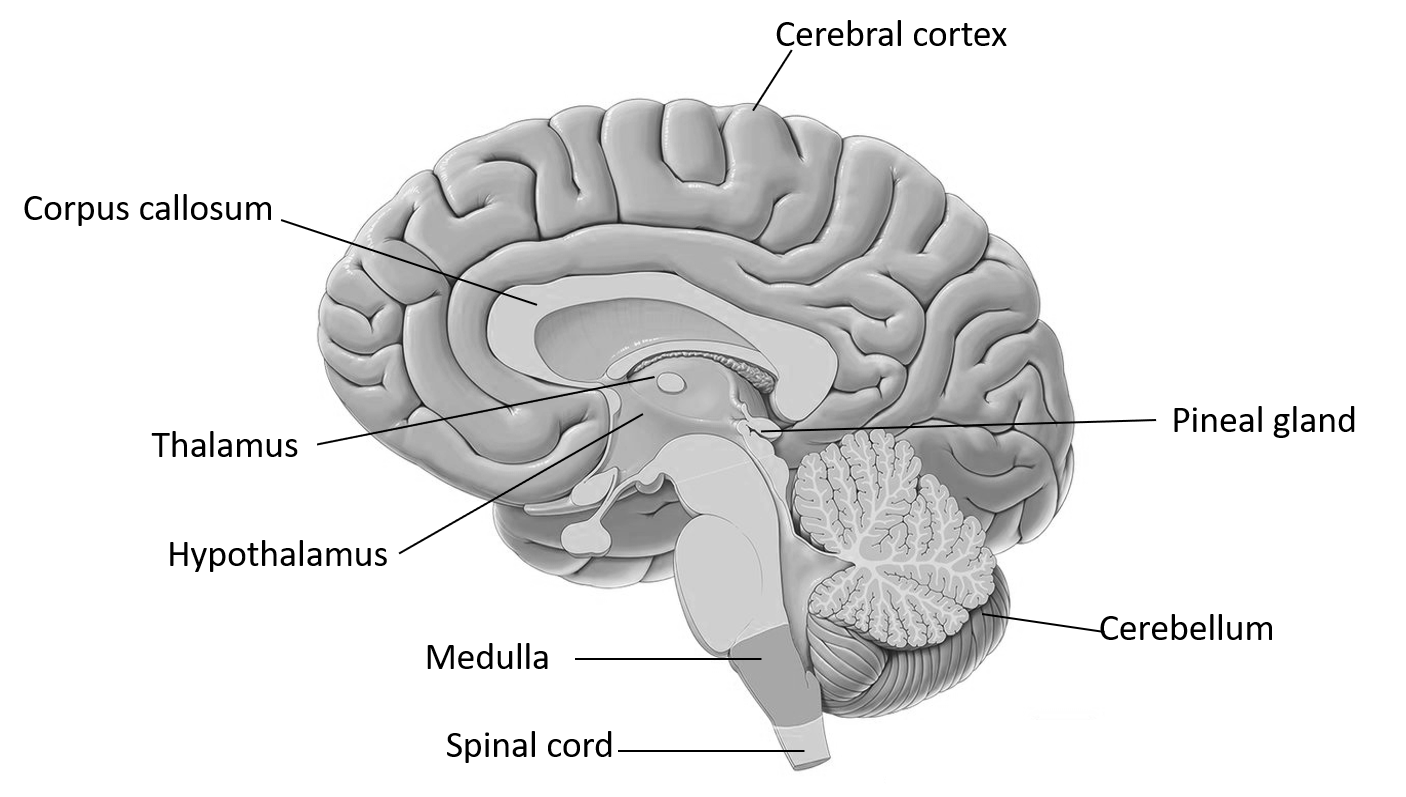
Draw the diagram of the human brain. Explain its functions.
Answer
512.2k+ views
Hint: It constitutes the central nervous system and is responsible for thoughts, and sending and receiving of signals.
Complete answer:
A brain is located in the head, close to the sensory organs. It is mainly composed of neurons which are the fundamental unit of the brain and nervous system. The brain along with the spinal cord together form the center of the nervous system.
Parts of the brain
1. Forebrain – anterior and largest part of the brain. It includes:
- Cerebrum – is responsible for thinking, intelligence, memory, and sensory organs.
- Hypothalamus – it is responsible for sending information from the sensory organs.
- Thalamus – it controls body movement, temperature, hormones, and other metabolic mechanisms.
2. Midbrain – the smallest and central part of the brain. It consists of:
- Tectum – it controls reflex movement from the head, eye, and neck impulses.
- Tegmentum – it consists of the brainstem and helps in body movement and reflexes.
3. Hindbrain – central region of the brain. It consists of:
- Cerebellum – it is responsible for coordinating and maintaining body equilibrium and controlling voluntary movements.
- Medulla – it controls the body’s autonomic functions like breathing, heartbeat, etc.
- Pons – it transfers signals between the lower and higher parts of the brain.
Functions of the brain
-The cerebral cortex of the brain helps in the perception of light, sound, movement, temperature, etc.
-It controls the breathing patterns and sleep of an individual.
-It is responsible for voluntary motor activity.
-The brainstem is the posterior part of the brain which helps in the regulation of the sleep cycle.
-The lobes of the brain are associated with the processing of memory and hearing.
-The group of structures present in the center of the brain is the basal ganglia which help in coordinating messages to various areas of the brain.

Note: By the first century A. D., Alexandrian anatomists such as Rufus of Ephesus had provided a general description of the brain. In the next century, Roman physician Galen concludes that mental activity occurred in the brain instead of the heart. During the sixteenth and early seventeenth century, the English physician Thomas Willis published his book Anatomy of the brain in 1664 and the Danish anatomist Nicolaus Steno published his lecture on the anatomy of the brain in 1669. After their proposals, the new concept of the brain was introduced.
Complete answer:
A brain is located in the head, close to the sensory organs. It is mainly composed of neurons which are the fundamental unit of the brain and nervous system. The brain along with the spinal cord together form the center of the nervous system.
Parts of the brain
1. Forebrain – anterior and largest part of the brain. It includes:
- Cerebrum – is responsible for thinking, intelligence, memory, and sensory organs.
- Hypothalamus – it is responsible for sending information from the sensory organs.
- Thalamus – it controls body movement, temperature, hormones, and other metabolic mechanisms.
2. Midbrain – the smallest and central part of the brain. It consists of:
- Tectum – it controls reflex movement from the head, eye, and neck impulses.
- Tegmentum – it consists of the brainstem and helps in body movement and reflexes.
3. Hindbrain – central region of the brain. It consists of:
- Cerebellum – it is responsible for coordinating and maintaining body equilibrium and controlling voluntary movements.
- Medulla – it controls the body’s autonomic functions like breathing, heartbeat, etc.
- Pons – it transfers signals between the lower and higher parts of the brain.
Functions of the brain
-The cerebral cortex of the brain helps in the perception of light, sound, movement, temperature, etc.
-It controls the breathing patterns and sleep of an individual.
-It is responsible for voluntary motor activity.
-The brainstem is the posterior part of the brain which helps in the regulation of the sleep cycle.
-The lobes of the brain are associated with the processing of memory and hearing.
-The group of structures present in the center of the brain is the basal ganglia which help in coordinating messages to various areas of the brain.

Note: By the first century A. D., Alexandrian anatomists such as Rufus of Ephesus had provided a general description of the brain. In the next century, Roman physician Galen concludes that mental activity occurred in the brain instead of the heart. During the sixteenth and early seventeenth century, the English physician Thomas Willis published his book Anatomy of the brain in 1664 and the Danish anatomist Nicolaus Steno published his lecture on the anatomy of the brain in 1669. After their proposals, the new concept of the brain was introduced.
Recently Updated Pages
Why are manures considered better than fertilizers class 11 biology CBSE

Find the coordinates of the midpoint of the line segment class 11 maths CBSE

Distinguish between static friction limiting friction class 11 physics CBSE

The Chairman of the constituent Assembly was A Jawaharlal class 11 social science CBSE

The first National Commission on Labour NCL submitted class 11 social science CBSE

Number of all subshell of n + l 7 is A 4 B 5 C 6 D class 11 chemistry CBSE

Trending doubts
10 examples of friction in our daily life

One Metric ton is equal to kg A 10000 B 1000 C 100 class 11 physics CBSE

Difference Between Prokaryotic Cells and Eukaryotic Cells

1 Quintal is equal to a 110 kg b 10 kg c 100kg d 1000 class 11 physics CBSE

State the laws of reflection of light

Explain zero factorial class 11 maths CBSE




